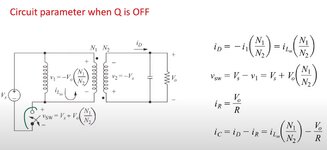DrFloyd
Newbie
Hello,
I'm starting with flyback converter theory. In continuous mode I understand from web that when energy is transferred to the second winding (off state) the secondary voltage (equal to load and capacitor voltage) is constant and current decreases. The energy from the transformer core recharges capacitor and supplies the load. How the capacitor can be charged if voltage is constant? How does capacitor voltage change during off state?
Thank you
I'm starting with flyback converter theory. In continuous mode I understand from web that when energy is transferred to the second winding (off state) the secondary voltage (equal to load and capacitor voltage) is constant and current decreases. The energy from the transformer core recharges capacitor and supplies the load. How the capacitor can be charged if voltage is constant? How does capacitor voltage change during off state?
Thank you
